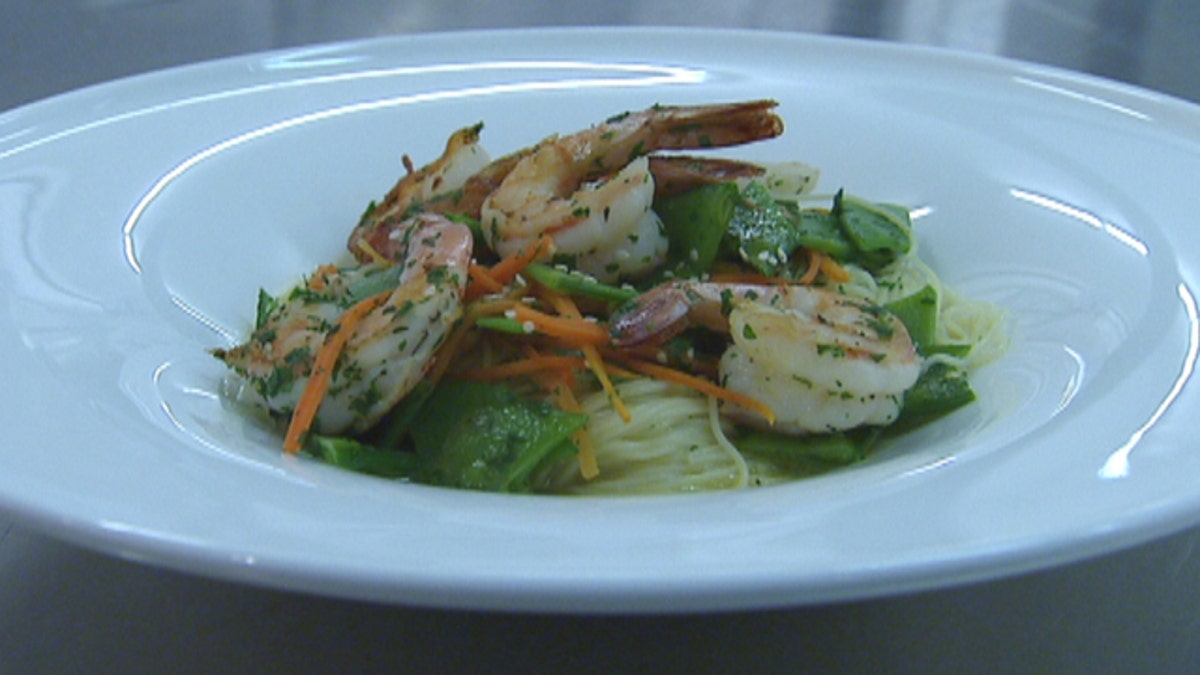
Sauteed Shrimp with Angel Hair Pasta
Marc Bauer is not your typical French chef: He does not finish sauces with two grams of butter or create soups that are 20 percent cream.
So is Bauer, who was born and raised in Alsace, France, a calorie-counting, flavor-sacrificing chef?
Not by any means.
Bauer, who is now based in New York City, along with an estimated 100 million other Americans, suffers from acid reflux . Rather than abandon rich, savory ingredients, Bauer teamed up with Dr. Jamie Koufman, the director of the Voice Institute of New York and professor of Otolaryngology at New York Medical College, to create delicious recipes that will not upset the digestive tract of those who suffer from acid reflux. They compiled these recipes into Dropping Acid: The Reflux Diet Cookbook & Cure.
The layout of this cookbook is both culinary and educational, with 70 of the 200 pages dedicated to information on acid reflux, including things to avoid, items to enjoy and even a three page chart of pH levels found in common foods, vegetables and condiments. At the bottom of each recipe is a notes section where Bauer provides technical, cooking gems. Bauer stressed that in all of the recipes, he uses simple ingredients, which are available to all people, from New York City to the Midwest.
Acid reflux occurs when the acidic contents of the stomach pass up into the esophagus, and the sphincter muscle (the barrier between the two) has a defect, so it is unable to block the acid.
Causes of acid reflux can include, but are not limited to: a sphincter having low pressure, pregnancy, hiatal hernia and obesity.
Doctors often prescribe proton pump inhibitors like Nexium or Pepcid to treat the condition, but sometimes surgery or lifestyle changes are needed.
“I don't like medications,” Bauer confessed. “That was one of my interests in working with Drs. Stern and Koufman on this cookbook. I'm really not for using medication, but my life is stirring around food, fresh ingredients, quality ingredients.”
Bauer remembered as a kid in France feeling as if acid was in his throat after eating certain foods high in fat, like smoked pork or Bavarian cream pie, but he had never heard of acid reflux.
“Now in the past few years, what I feel is more like a coughing after eating,” Bauer explained. “I cough, and you would think, ‘Oh, I swallowed something wrong,’ and then it will stop after a while.”
Koufman said the symptoms of acid reflux are more than heartburn and indigestion for some.
“Having the sensation of a lump in their throat, hoarseness, chronic cough, difficulty swallowing, sore throat and sometimes even sinus and asthma can have reflux as its primary cause,” Koufman said.
Although foods that bring about acid reflux vary from person to person, some common triggers are onions, citruses, eggs, fatty meats, deep-fried foods, hot sauces and high-fat milk chocolate.
In addition, people who have acid reflux should steer clear from bottled and canned products because acid is added to help kill bacteria. Alcohol most likely will not cause acid reflux when consumed in moderation but timing must be taken into account.
Koufman said that a glass of wine right before bed may trigger acid reflux, while a glass with dinner can go unnoticed.
While writing the cookbook, she and Bauer measured the acidity of foods in order to modify, substitute, and limit acidic ingredients.
“It's not a question of avoiding everything with acid,” Koufman noted. “There's this concept called pH balancing, which is really new. This idea that we can use things that would typically be associated with reflux in our recipes and as long as the whole recipe is non acidic then we're OK.”
Koufman and Bauer substitute and balance foods in an innovative way, fusing culinary techniques with medical knowledge. A basic example Koufman provided was in terms of breakfast. If you enjoy fruits that are acidic, like strawberries, you can add them into your cereal because the milk is non-acidic.
Bauer described how to make a healthy, summer pea shooter with sautéed porcini. First, rather than boil the peas, Bauer put fresh baby peas into a blender, along with chicken stock and a tablespoon of brown sugar. The chicken stock is a flavorful, fat and acid free ingredient and the blender creates a smooth, creamy texture, without the use of fatty ingredients. Another way
Bauer accomplishes both savory and healthy meals is “pops of taste”. In this recipe, porcini mushrooms are the bursts of flavor, sautéed in butter but pat dry before added to the soup.
Rather than replicating a French soup containing 20 percent cream, Bauer adds six tablespoons of whole milk that accumulate to 2 percent fat.
“It's unbelievable the response,” Koufman said. “I get letters every single day from patients; they say, ‘thank you, I'm off my medications’ or ‘the medicine wasn't working’. Every single day. And the recipes are great and the recipes are doable.”
